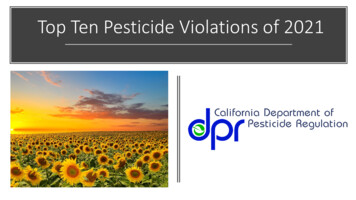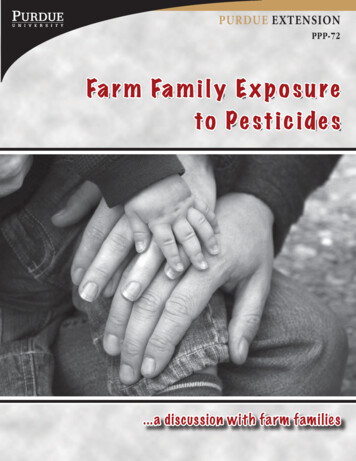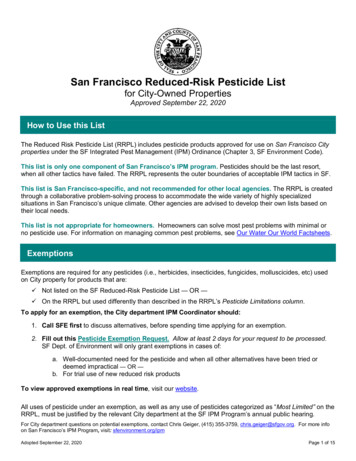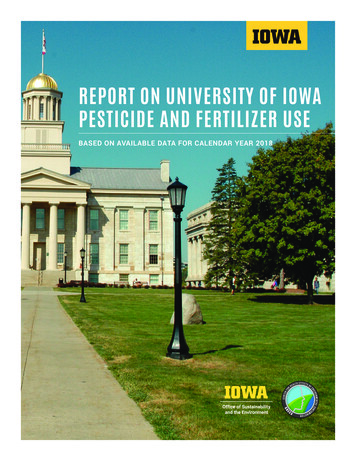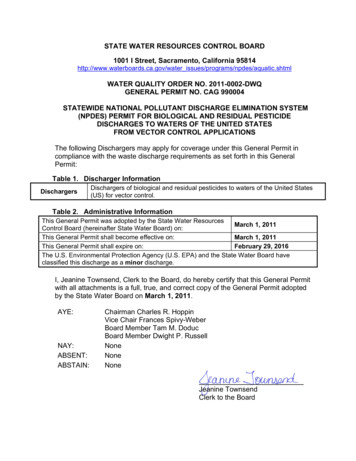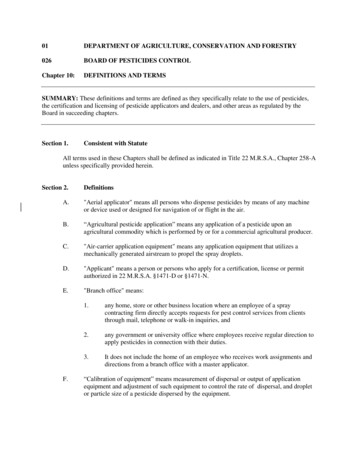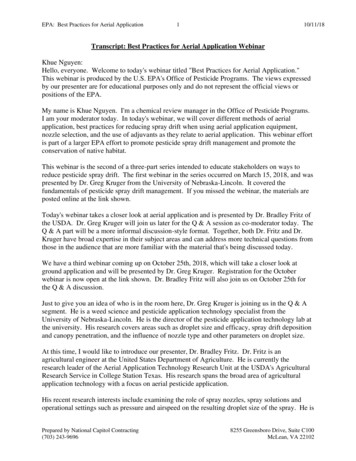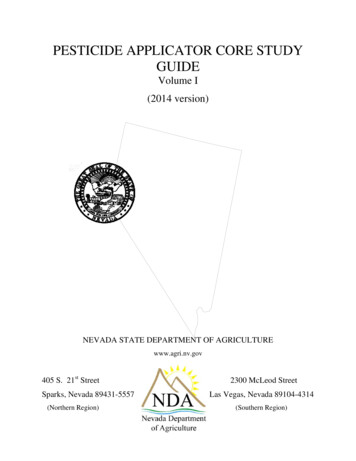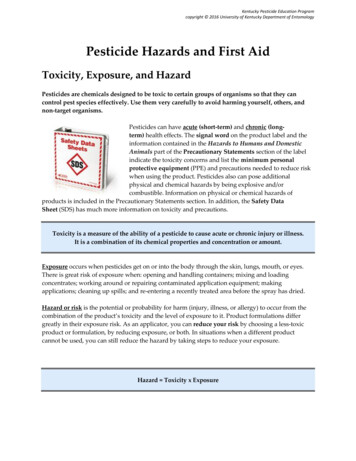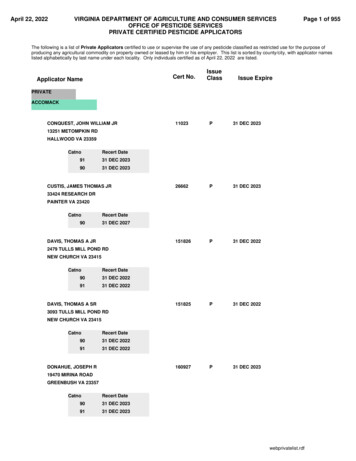
Transcription
Pesticide ApplicationCompiled byS.K. Pal and S.K. Das GuptaSkill Development Series no. 17ICRISATTraining and Fellowships ProgramInternational Crops Research Institute for the Semi-Arid TropicsPatancheru 502 324, Andhra Pradesh, India1996
Pesticide ApplicationCompiled byS.K. Pal and S.K. Das GuptaSkill Development Series no. 17ICRISATTraining and Fellowships ProgramInternational C r o p s Research Institute f o r the Semi-Arid T r o p i c sPatancheru, A n d h r a Pradesh 502 324, India1996
Training and Fellowships ProgramPublications in this Skill Development Series (SDS) are issued semiformally for limited distributionto program participants, colleagues, and collaborators. Copies may be requested by the SDSnumber. Constructive criticism from readers is welcomed by: Program Leader, Training andFellowships Program, ICRISAT. Contributors for this issue are Mr. S.K. Pal, Manager, PlantProtection, Farm Engineering and Services Program, and Dr. S.K. Das Gupta, Senior TrainingOfficer, Training and Fellowships Program.AcknowledgmentsInformation presented in this document has been taken from published and unpublished reports.Efforts have been made to indicate trade names ( ) where available. Omissions or inclusionsof a trade name does not constitute endorsement or discrimination of a product by ICRISAT orthe compilers. This publication should not be cited as a reference.Comments and suggestions from Mr D.S. Bisht and Mr C. Ram Reddy, and Mr V.S.R. Dasfor compiling this document are gratefully acknowledged. Thanks to Ms Smitha Sitaraman, MrS.V. Prasad Rao and Mr A. Vasanth Reddy for editing and processing this publication.
ContentsPlant Protection EquipmentDifferent Types of Plant Protection Equipment Generally UsedSelection and Use of Spraying Equipment111Pesticide Application Techniques3Commonly Used Spraying Equipment51.2.3.4.5.6.7.Hand-operated Hydraulic SprayersPower-operated Hydraulic SprayersAir Carrier Sprayers (Mist Blowers)Electrodyne Sprayer (Electrostatic Sprays)The Birky SprayerControlled-droplet Application (CDA) SprayersDusters5799101012Different Types of Nozzles and their Main Uses13Maintenance and Safe Handling of Equipment19Storage of Equipment20Hints for Trouble-shooting21Safety Precautions25Suggested Books for Reading30
Plant Protection EquipmentSelecting the right equipment for pesticide application is important for successful pest control.The correct usage of equipment and its proper maintenance are important factors which affectthe ability to place pesticides on target more economically and effectively. The choice ofequipment depends on its specific use and the need of a particular pest control measure.Different Types of Plant Protection Equipment GenerallyUsed Hand sprayers and atomizersHand compressed sprayersKnapsack sprayersTractor-mounted sprayerMotorized knapsack mist blowersUltra low volume or controlled-droplet applicators (ULV/CDA)Fogging machines/fogair sprayersHand-carried dustersHand-carried granule applicatorsPower dustersAerial application (Aircraft sprayers)Injectors and fumigation equipment.Selection and Use of Spraying EquipmentSpraying equipment (Fig. 1) should be selected on the basis of: frequency of pesticide application,availability of diluent (water, oil, kerosene, etc.),availability of labor (human or animal power),area requiring treatment,characteristics of area (machine equipment for large areas, hand-operatedequipment for smaller areas),durability of equipment,cost of equipment,availability of after sales service,operating cost, andspeed required to treat an area (this will depend on type of crop, stage of cropgrowth, and volume of spray solution to be applied).TAFPSDS no. 171
entWhichOperatingcostlaborequipment ipmentFigure 1. Factors governing the selection of spraying equipment.2TAFPSDS no. 17
Pesticide Application TechniquesT h e m e t h o d s u s e d to apply agricultural chemicals on crops a n d herbicides on w e e d s or on soil,are k n o w n as application techniques (Fig. 2). Appropriate d o s a g e a n d even distribution of spraydroplets on a target area are of paramount importance (Fig. 3 a n d 4). Chemicals are u s e d ind o s e s r a n g i n g f r o m 1 0 0 g or less to as h i g h as a f e w L a n d kg ha - 1 . C a r r i e r s or d i l u e n t s a r em i x e d with chemicals to ensure even distribution. T h e most important diluent-carrier is water.W h e n u s e d a s a p e s t i c i d e carrier, its v o l u m e s h o u l d b e v a r i e d w i t h t h e m e t h o d o f a p p l i c a t i o n( T a b l e 1).WrongwayCorrectWayFigure 2. The correct and wrong ways of spraying.Table 1.V o l u m e of water or any diluent carrier at f l o w e r i n g s t a g e .VolumeField c r o p s (L ha - 1 )High volume (HV)M e d i u m volume (MV)L o w v o l u m e (LV)Very low volume (VLV)Ultra low v o l u m e (ULV) 600200-60050-2005-50 5TAFPT r e e s a n d b u s h e s ( L ha - 1 ) 1000500-1000200-50050-200 50SDS no. 173
Figure 3. Overlap of spray ction.Figure 4. Overlapping of swaths as the operator moves upwind across a field.4TAFPSDS no. 17
The efficacy of a pesticide in any application technique is mainly influenced by thefollowing three factors: Mean level of deposit (dosage): This refers to the total amount of toxicant (activeingredient) used in treating a unit of the target area; Distribution of deposit: The surface of the leaf may be completely covered by a chemical(active ingredient) deposit in the case of runoff (high volume) spray, but the deposit maybe unevenly distributed; and Wetting agents tend to decrease droplet size and increase spreads, and low-volatilitycarriers help prevent the evaporation of small droplets (low and ultra low volumes) andensure better distribution.Importance of Droplet SizeDroplet size plays a very important role in pesticide application by minimizing environmentalcontamination. Pesticide sprays are generally classified according to droplet size. When drift isto be minimized, a medium or coarse spray is required irrespective of the volume applied (Table2).Table 2.Classification of sprays according to droplet size.V o l u m e m e d i u m diameter of droplet (μm)1C l a s s i f i c a t i o n of d r o p l e t s i z eAerosolMist 5051 - 100101 - 2 0 0201 - 400 400Fine sprayMedium sprayCoarse spray1 . T h e m o s t w i d e l y u s e d p a r a m e t e r o f d r o p l e t size i s v o l u m e m e d i u m d i a m e t e r ( V m d ) w h i c h i sm e a s u r e d in m i c r o m e t e r s ( μ m ) . 1 m i c 1/1000 m m .Commonly Used Spraying Equipment1.2.3.4.5.6.7.1.Hand-operated hydraulic sprayers (knapsack sprayers)Power-operated hydraulic sprayers (tractor-mounted sprayers)Air carrier sprayers (mist blowers)Electrodyne sprayers (electrostatic sprayers)Birky sprayers (Birky knapsack sprayers)Controlled-droplet application sprayersDustersHand-operated Hydraulic SprayersThese sprayers are the most widely used. They are small and compact e.g., knapsack and handcompressed sprayers.TAFPSDS no. 175
Knapsack sprayers (lever operated)The lever-operated (piston/diaphragm type) knapsack sprayer is one of the most commonly usedsprayers. In this equipment, liquid is drawn through a valve into a pump chamber with the firststroke. When the lever returns to its original position, the liquid in the pump chamber is forcedpast another valve into a pressure chamber. The valve between the pump and the tank is closedduring this operation to prevent the return of the liquid into the tank. A good seal between thepump and cylinder is obtained by a 'cup washer' or 'O' ring. As liquid is forced into thechamber, air is trapped in a part of the pressure chamber and compressed. This forces the liquidfrom the pressure chamber through a hose into the nozzle. Compression sprayers, handsprayers, and shoulder-slug compression sprayers fall under this category.Calibration of spraying equipmentTo achieve good results from spraying, the sprayer must be clean and in working condition. Itmust be calibrated before every major spraying operation so that the exact quantity of spray isdelivered on the target, which may be plants in the case of insecticide application or soil in thecase of herbicides.The volume of application depends on the: droplet size the sprayer can deliver (depending on the size of the orifice of the nozzle tip),surface area to be sprayed/applied,weather conditions,pesticide formulations (EC, WP)availability of diluent,spraying pressure (maintain uniform pressure throughout the operation),uniform spray swath, andspeed of an operator/tractor: maintaining a tractor's or operator's (in the case of manualoperation) constant forward speed is essential.Calibration of knapsack sprayers (refer to SDS no. 15 - Pest Control)a.b.c.d.e.Rinse and clean the sprayer.Determine nozzle discharge (by selecting a nozzle) in L min -1 at known pressure(V).Calculate the walking speed of the operator (starting point, end point) in M min -1(L).Determine the width of the spray swath in meters (W).Calculate the area sprayed in one minute (W x L) M 2 min -1Area sprayed min -1 Swath width of spray x Forward speed min -1 .f.The application rate for any given area:Volume of spray in L unit -1 area Nozzle discharqe (L min -1) x AreaArea sprayed min -1orL ha-1 6TAFPV x 10000LxWSDS no. 17
g.Calculate the number of spray loads ha -1Loads ha-1 Rate of application ha-1Tank capacity of sprayerExample:a.How many liters of the commercial formulation Rogor 30 EC (dimethoate) isrequired to treat an area of 0.5 ha, if the recommended dose is 0.1%?Compute the total volume of spray (in L) needed to treat the areaVolume of spray after sprayer calibration:EC form:Recommended dose:Area to be treated:320 L ha-1R o g o r 30 EC0.1%0.5 ha320 L x 0.5 ha 160 LFormula:Amount of spray required x % of spray concentrate% of ai (EC)160 L x 0.1 0.533 or 533 mL.45Therefore, 533 mL of Rogor 30 EC must be mixed in 160 L of water to spray 0.5 ha.2.Power-operated Hydraulic SprayersTractor-mounted sprayersThe tractor-mounted boom sprayer with a pump driven from the power take off (PTO), is used toapply 50-500 L ha -1 on field crops over a large area. Tanks with a large capacity may bemounted on trailers or as saddle tanks along side the tractor engine to spread the load moreevenly. Some large sprayers are self propelled. However, these are used only where sufficientflat land allows the use of booms up to 27 m wide.The important components of power-operated sprayers are:a.b.Tank mounted on a sprayerPumps: piston, centrifugal, gear, roller-vane, and diaphragm pumps.c.d.e.Pressure controlling devices: Pressure gauge and Pressure Relief Valves (PRV).Nozzles: hydraulic nozzles; impact nozzles: cone nozzles and fan nozzles.Agitators.Calibration of tractor-mounted sprayerThis sprayer is calibrated by allowing it to travel over a known distance and then measuring thevolume of chemical applied (in liters). The width of the swath must be measured (in meters) whilekeeping the distance between the nozzle and ground level constant. The pump pressure andtravelling speed must be constant. The following parameters are important for calibration:TAFPSDS noo. 177
Example:pressure in tank,nozzle size (tip),forward speed of tractor, andswath width of spray.Calibration of a tractor-mounted sprayer (Allman) for spraying 300 L ha -1 .Number of nozzles:Swath width of boom:Area to be sprayed:28 (fitted 50 cm apart)14 m (50 cm x 28 nozzles)1 haDistance travelled (forward speed) by tractor:Area covered by tractor in one pass:Nozzle discharge min -1 :Discharge from 28 nozzles:Discharge of spray solution over an area of 1400 m 2 :Discharge of spray solution over 1 ha (10000 m 2 ):100 m min -1 (6 km h-1)100 m x 14 m (swath) 1400 m 21.5 L min -1 (one nozzle)1.5 L x 28 42 L42 L10000 x 42 300 L1400Therefore, 300 L ha -1 can be obtained with these parameters.Calibration of a tractor-mounted sprayer with various ndspeedkm h-1(dischargeL min -1)Nozzletipsize1231st high4th low4th low4th notch3rd notch2nd notch7 km6.5 km6 km1.0 LM-11.25 LM-11.5 LM-1PressurePSi283235Output(L ha'1)265290300300 L ha-1Sprayer calibration aims at obtaining a spray pattern and droplet size that will ensure optimumcoverage of a target area with uniform sized droplets without causing runoff. Calibration should,therefore, take into account: Target area:water). Droplet size: fine droplets cover a large area with less volume and reduce runoff, but cancause more drift and evaporation losses under warm and windy conditions. Once the volume of spray and droplet size are determined, the nozzle size and theirspacing on the boom should be decided keeping in view the height between the boom andthe crop canopy.8canopy area to be sprayed (a large leaf area requires a large volume ofTAFPSDS no. 17
All hydraulic nozzles work effectively only within a given pressure range. The sprayerpump should, therefore, deliver the required volume with the correct pressure. To do so,the tractor must be driven at an optimum speed (engine rpm) in order to deliver powerthrough PTO or hydrostatic drives to the pump input. Given that the type of nozzles, pressure obtained, tractor rpm, spray swath, etc., remainconstant, the only variable that can be adjusted is the volume of spray/unit area with thespeed of the tractor. This can be done by gear selection (if the engine speed is fixed). The volume ha' 1 can be regulated by slightly adjusting the pressure regulator or enginespeed with little effect on pump output.3. Air Carrier Sprayers (Mist Blowers)The use of portable air carrier sprayers, known as motorized knapsack mist blowers, follows thedevelopment of light weight, two-stroke engine aeroplanes suitable for aerial spraying over largeareas.The fan in these sprayers produces a high velocity air stream which is diverted througha 90 elbow to a flexible discharge hose. The most common nozzle fitted in these sprayers isthe shear nozzle (gaseous energy nozzle). Air is drawn into the fan at a high speed anddischarged through a flexible tube in which a liquid flow nozzle is mounted. As the high velocityair stream passes over the nozzle, it makes the emerging liquid break into droplets which thenenter the air stream and are sprayed.Calibration of knapsack motorized mist blowera.b.c.Check all the components of the sprayer to see if they are in working condition.Fill the sprayer with water sufficient for at least 1 minute of spraying.Record the time taken to spray the measured volume with a stop watch.4.Electrodyne Sprayer (Electrostatic Sprays)The functioning of the electrodyne sprayer is based on a system which atomizes and propelscharged droplets of chemical spray by electrical forces set up between a nozzle with a positivehigh voltage charge. Since the charged droplets are readily deposited on an 'earthed' object,e.g., a plant, the total deposit on the foliage can be significantly increased compared to unchargedsprays.The liquid pesticide is poured into a bottle and fed by gravity to the nozzle, where it picksup charged droplets (positive charges) generated by batteries. The liquid leaves the nozzle ina number of uniform ligaments which break up into electrically-charged droplets. The positivelycharged droplets move along curved electrical field lines towards and around the plants, coveringthe visible as well as hidden surfaces. The size of the droplets range between 20 and 200microns.A special feature of this type of sprayer is that the formulations used in it come in aspecial bottle fitted with the particular nozzle required.TAFPSDS no. 179
5.The Birky SprayerThe Birky knapsack sprayer is the first low volume (LV) spinning disc sprayer which does notrequire batteries. The need to apply herbicides at very low volumes gave rise to this sprayer.The spinning disc of the Birky sprayer is driven by air supplied by a pneumatic pump toa turbine. Since it has no batteries, it reduces spraying cost. The spray swath can be increasedto about 1.6 m.Some of the advantages of a Birky sprayer are: A low water requirement that makes it ideal where water is not readily available.Its one spray-load covers 1/4 of an hectare (20 L ha -1 ).A working output of 3-4 ha day' 1 , compared to one hectare by the knapsack sprayer.Requires less physical effort to operate and is less tiring for the operator.A pneumatically-driven disc.Easy to maintain and has a wider spray swath.Droplet size ranges between 250 and 300 microns.Operation of a Birky sprayer: 6.Calibrate the sprayer before spraying in the same way as is done in the case of aknapsack sprayer.Start operating the handle to obtain the correct speed of the spray disc (a whistling soundwill be heard).Open the tap. Swing the spray tube sideways to check the proper flow and atomizationof the spray solution.Start spraying and maintain a proper ground speed.Swing the spray tube sideways from time to time to check whether the sprayer is workingproperly.Controlled-droplet Application (CDA) SprayersThese sprayers (Fig. 5) apply the correct size and uniform droplets on a given target area so thatoptimimum use is made of the spray volume and dosage. It is a logical extension of the ultra lowvolume (ULV) concept.The most promising method of controlling droplet size within fairly narrow limits is by usingcentrifugal energy nozzles (spinning discs or cups) which adjust droplet size by varying theirrotational speed. A suitable formulation and flow rate are selected so that at a given rotationalspeed, droplet formation is from ligaments with a minimum number of satellite droplets.The volume of spray depends not only on the droplet size selected but also on dropletdensity. Uniform droplet density can be obtained by using as little as 500 mL ha -1 of theformulation with a droplet size of 46 m or 1-8 L ha -1 at 70 μm or 200 L ha -1 at 340 μm droplets.Spraying procedureTo avoid contact with the spray, the drift operator must walk progressively up-wind across thefield through nontreated crops. The sprayer is held either with the handle across the front of theoperator's body or over his shoulder, with the disc above the crop pointing downwind. The10TAFPSDS no. 17
Figure 5. Controlled-droplet application sprayer.TAFPSDS no. 1711
spinning disc is normally held 1 m above the crop. It may be necessary to hold it lower whilespraying the first swath along the leeward side of a field in order to reduce the chemical's driftoutside the treated area.7.DustersAppliances that are used for distributing dust formulations are called dusters. Dusters may bemanually or power operated. Machines used for applying dusts mainly consist of a hopper (dustchamber) with an agitator, an adjustable orifice or other metering mechanism, and delivery tubes.Some dusters are power operated, e.g., motorized mist blower-cum-dusters, tractor-mounteddusters, and rotary dusters.The following types of power dusters are generally in use:Tree dusterThis duster has an upright metallic discharge tube varying in length from 1 to 4 feet, which helpscarry the dust upwards to the trees. The height upto which the dust can be carried depends onthe length of the tube and the engine's horsepower. Generally a long hose (10 feet) is used todust tall trees.Row crop dusterThis duster has 4-8 outlets in the fan chamber. Each outlet is connected by flexible pipes meantto spread the dust, and arranged on an iron rod in the rear of the tractor for delivering the dustright on the crop. Crops grown in a row are most suitable for treating with these dusters. Rowcrop dusters can be fitted on to any vehicle or animal-drawn trolley and can dust vast areas.All-purpose dustersThese range from the small knapsack and wheel barrow or skid type dusters to the large tractoror vehicle-mounted power dusters. They usually have a single delivery outlet connected to a 4-6foot multidirectional flexible delivery pipe. They are used for all kinds of crops except tall trees,and can dust 20-30 acres day -1 depending on crop height and formulation dosage.Self-propelled dustersPower dusters of this type are mounted on a frame carried by 3 or 4 wheels driven by an engine.Motorized knapsack sprayer-cum-dustersThese dusters are light in weight, generally powered by 0.5 - 1 . 0 hp engines, and can be carriedon an operator's back. The frame has a shock proof cushion with shoulder straps.The hopper and delivery hose pipes are small and the tank can hold upto 8-10 kg of dust.The machine's total weight with the dust can be around 20 kg.These dusters can be converted into a sprayer (mist blower) by removing the agitatingtube from the tank and fixing the hose in the outlet of the chemical tank.12TAFPSDS no. 17
The advantages and disadvantages of dusting over spraying.AdvantagesDisadvantagesTreatment costs lessHigher cost of active ingredientCovers a larger target area than sprayingUneven deposition and poor adherence to thecanopyEquipment is light in weight and easy tohandleLimited choice of dust formulationsDust formulations have a greater shelf lifethan EC and deteriorate less rapidlyDusting cannot be done when very windyWeather condition is a constraint (dustwashes off after rain)Different T y p e s of Nozzles and their Main UsesNozzles are an important part of spraying equipment. They vary in their delivery system.Hydraulic Energy NozzlesIn this type of nozzle, liquid under pressure is forced through a small opening. The velocity ofthe liquid breaks it into droplets. Properties of the liquid, such as surface tension, specific gravity,and volatility influence the delivery of the spray mix.The various types of hydraulic energy nozzles are: Cone jet nozzles:sprays (Fig. 6).Hollow cone jet and solid cone jet which are used for foliage Flat fan: This is used for spraying on flat surfaces and in aerial spraying. Impact nozzle or flood jet: This is a low pressure nozzle with coarse spray, mainlyused for herbicide application (Fig. 7). Other types:The adjustable nozzle (Fig. 8) and the swirl nozzles (Fig. 9) forspraying in two different directions.The main components of a hydraulic spray nozzle are: BodyCapStrainer-sieveTipTAFPSDS no. 1713
Front view(Types from left)Flat fanFlood jetHollow coneHollow coneSide view(Types from left)Flat fanFlood jetHallow coneHallow coneFigure 6. Different types of nozzles.14TAFPSDS no. 17
Figure 7. An impact nozzle.Figure 8. An adjustable nozzle for distant target.Figure 9. A swirl nozzle used for spraying in two different directions.TAFPSDS no. 1715
The pattern of droplet distribution and the amount of liquid sprayed (Fig. 10) depend on: type and design of nozzle,diameter of nozzle orifice,discharge angle of spray,operating pressure (P),fluid sprayed, andweather conditions.G a s e o u s E n e r g y S p r a y N o z z l e s ('Twin-fluid')In this kind of nozzle, the liquid disintegrates into droplets by the impact of a high speed airstream on the spray liquid. Droplets are formed at a relatively low air pressure (less than 0.3bar). However, when fine (aerosol) droplets are required, the volume of air must be increased.The rate at which the liquid flows into the nozzle depends on its viscosity. An increased flow ofliquid and lower air speed result in large droplets which are mainly used for spraying on trees andbushes.Centrifugal Energy NozzlesThe spray liquid is fed near the center of a rotating disc in these nozzles. The liquid is uniformlydistributed to the serrated periphery of the disc by centrifugal force. It is propelled from the edgeof the disc in the form of ligaments, and breaks down into droplets. A lower rotational speed andhigher flow rate result in larger droplets. This nozzle is mainly used to apply low volumes withcontrolled droplet size and also in air-carrier sprayers.The diameter of a single droplet (d) produced by a rotary nozzle can be calculatedapproximately thus:d constantrpmwhere d droplet diameter (μm).Effect o f D r o p l e t S i z e a n d S p r a y C o v e r a g eDistribution of spray. Droplet size, density, and penetration can be visible on water-sensitivepapers tagged on to a plant at different heights. Droplets deposited on the plant surface spreadand increase up to 3 times in size. The smaller the droplet, the greater the spread factor.N o z z l e E r o s i o n a n d S p r a y PatternThe accuracy of the deposition of spray droplets depends on the nozzle. The orifice of the nozzletip gets enlarged over a period of time by the combined effects of the chemical action and theabrasive effect of the particles.These may be in the 'filler' portion of wettable powderformulations, where foreign particles are frequently suspended in the spray. This is referred toas nozzle-tip erosion and results in an increase in liquid flow rate, droplet size, and an alterationin spray pattern. An increased flow rate can lead to an overdose of pesticides. The dischargefrom a nozzle or group of nozzles can be measured with a patternator (Fig. 11), which monitorsthe liquid discharged through a flow meter. Water is sprayed into one, two or three nozzles onto a channelled table and collected in a sloping section which drains into calibrated collecting16TAFPSDS no. 17
Flat fanHollow coneFlat jetFigure 10. Nozzles and their spray patternTAFPSDS no. 1717
Figure 11. A patternator18TAFPSDS no. 17
tubes at the end of the channels. The nozzle is usually mounted 45 cm above the trayandconnected to a similar spray line. The patternator can be placed under a tractor boom to findout the variation in spray distribution along its length. The coefficient of variation of a boompattern can be obtained when limits for individual nozzle patterns have been defined using afluorescent tracer technique to determine liquid distribution.Advantages nventionalsprayDisadvantagesProduces smaller and uniform sizedropletsThe smaller droplets tend to evaporate easilyand drift from the target areaThe smaller the droplet, the greater thespread factor and the better the coverageApplication has to be under ideal weatherconditionsNo diluent is requiredSelective in use of formulationsEasy to carry, use, and maintainHazardous to operator and surroundingsbecause of the use of high concentration ofchemicalsCovers large areas in less time and withless inputsLosses due to windWider swaths and no runoffStrict adherence to weather conditionsCalibration of EquipmentThe spray volume can be calculated theoretically by the following formula:Application rate in L ha-1 600 L x L min -1 (nozzle discharqe)Swath width (m) x Speed m min - 1Maintenance and Safe Handling of EquipmentRegular preventive maintenance of equipment is required so that the components which aresubject to wear and tear are replaced before they wear out. Proper maintenance of equipmentis, therefore, essential.Problems Associated with Spraying EquipmentNozzle blockagesIf a nozzle blockage occurs while spraying, the nozzle tip and filter should be replaced with cleanpoints. The blocked nozzle should be cleaned and spares should be taken to the field. Whenspares are not available, water or a solvent should be taken to the site of operation to clean theblockage. The occurrence of blockages can be reduced by filtering the spray liquid while fillingthe chamber.TAFPSDS no. 1719
Inefficient pumpsPumps are fitted with 'O' ring seals or leather or synthetic cup washers. As the seals can getdamaged due to suspended spray particles, they should be checked regularly. Apart fromcleaning and replacing damaged parts, it may be necessary to change the formulations used orto improve the filtration of water before use.Leakage'O' ring washers and other types of seals are liable to wear and tear or damage when hoseconnections, trigger valves, and other components are unscrewed.Compression sprayequipment and certain motorized knapsack mist blowers function properly provided they areairtight.Maintenance and safe handlinga.Daily maintenance b.Periodic preventive maintenance of the following is important: c.Clean after use.Check pump, nozzles, etc., before operation with water.Inspect mobile parts.PumpsPipes and connectionsPressure gauges and pressure regulatorsAgitatorNozzles and boomsTank componentsEngineOff-season maintenance and storage. All plant protection equipment must be stored ina cool and dry place and in the shade. Equipment should be washed thoroughly with plain water before storage.Grease and lubricants should be applied to joints and surfaces wherever requiredto protect from rust.Storage of EquipmentAfter each day's field work and at the end of the season, the sprayer's pump, control units,booms, hoses, and engine should be checked thoroughly before storing in a dry place. Allspraying equipment should be kept locked and away from children, food, and farm animals, andmeasures taken to prevent rats from nibbling at hoses and other parts. Many small hydraulicsprayers are preferably stored upside down with the lid removed to allow complete drainage offormulation. If engines are to be stored for a prolonged period, the spark plug should be removedand a little oil, preferably formulated with anti-rust additives, poured into the crank case. Theengine should be turned over a couple of times to enable the oil to spread evenly. At the endof each day, it is advisable to add some oil to any type of sprayer pump. This is not necessaryif the sprayer is to be used again the following day.20TAFPSDS no. 17
Hints for Trouble-shootingTwo-stroke EnginesProblemRemediesEngine does not startFault in fuel systemFuel cock has not been opened or isblockedEnsure there is suffici
growth, and volume of spray solution to be applied). TAFP 1 Plant Protection Equipment Selecting the right equipment for pesticide application is important for successful pest control. The correct usage of equipment and its proper maintenance are important factors which affect the ability to place pesticides on target more economically and .

